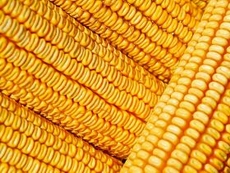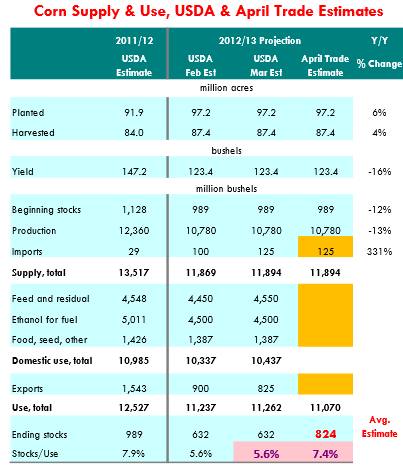 A poll of market analysts conducted by Dow Jones indicated that on average analysts expect USDA to revise higher its estimates of corn ending stocks for the 2012/13 marketing year.
A poll of market analysts conducted by Dow Jones indicated that on average analysts expect USDA to revise higher its estimates of corn ending stocks for the 2012/13 marketing year. The 1 March quarterly stocks survey pegged 1 March corn stocks at 5.4 billion bushels, almost 400 million bushels larger than what trade was expecting coming into the report. With the supply side of the balance sheet known (see table), it will be interesting to see how USDA will change its estimates of corn exports, ethanol use and feed use for the current marketing year.
Given the average of trade estimates per Dow Jones at 824 million bushels, the stocks/use ratio jumps to 7.4 per cent compared to 5.6 per cent in the March report.

How could the three main demand categories be impacted in the April update? Export numbers were lowered significantly in the March report, projected to be down 46.5 per cent from a year ago. Little has changed in corn export volume in recent weeks but it is likely that the lower prices will increase the quantity demanded in world markets.
US corn was trading at a significant spread to Argentinean corn in the second half of 2012 and early 2013. The spread has for the most part disappeared. Combined Argentina and Brazil corn exports in 2012/13 are currently projected to be 38 million MT, compared to a little over 20 million MT out of the US.
The main challenge for South America at this point is transportation, with wire stories this week noting Brazil may import Argentine corn to its Northeast areas even as other parts of the country have ample supplies.
The evolving situation in China with bird flu continues to be a concern in the overall picture of global feed demand, with trade keeping a close eye on the possibility that a full blown epidemic could lead to significant culling, a net reduction in feed demand and longer term impact on chicken and pork demand in one of the fastest growing markets for meat protein in the planet. The February corn export numbers down 58 per cent from a year ago and chances are USDA may lower the final corn export number to 800 million bushels.
Ethanol demand will likely be left unchanged. Ethanol production has increased in recent weeks following lower corn prices and improving margins. Daily ethanol output which was running about 15 per cent below year ago levels in January and February now is down 8 per cent from last year.
USDA will likely want to see a few more weeks of increasing ethanol output before making any meaningful changes to th e ethanol demand part of the balance sheet. Other industrial use numbers may be changed at the margin but chances are USDA will leave food, seed and other use unchanged.
Even if corn exports are revised modestly lower, the balance sheet implies that the feed and residual numbers will likely be revised lower. If the trade estimate of 824 million bushels is correct, and considering our discussion of exports and ethanol above, feed and residual for 2012/13 may be lowered by about 170 million bushels to about 4.380 billion bushels. This would represent a feed/residual decline of 3.7 per cent from the previous marketing year.
The March 1 grain stocks numbers implied that in the first half of the marketing year feed use was down about 6 per cent. While there are fewer cattle on feed, the hog and poultry numbers are larger than a year ago and they are increasing. Broiler egg sets up 1.1 per cent from a year ago. Feed use rationing was all the talk after the March 1 WASDE report. A month later, it looks like the job will be a little easier.





